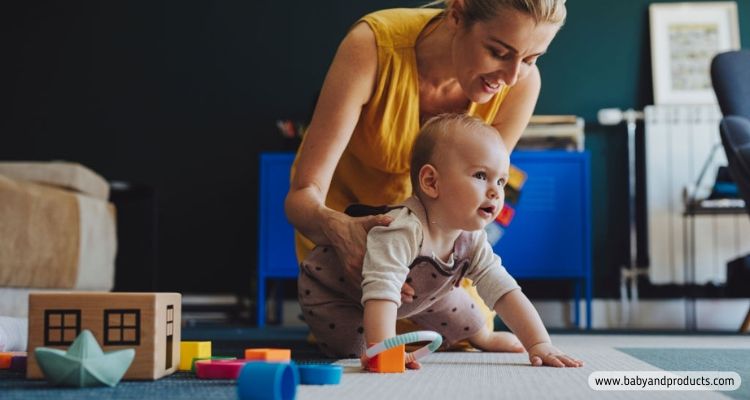It’s utterly unique when you capture the glimpse of your baby’s first move towards crawling. As a new parent, you eagerly await for your child to accomplish the anticipated milestones. From laughing, rolling over, lifting their head, and sitting up.
Crawling is one exciting and pretty complex milestone that most babies probably achieve between 6 to 10 months of their age. This little developmental goal may take a little longer for some infants because the babies are interested in developing other skills first.
This developmental milestone is always heart-warming to witness. There are a lot of activities that you can do to support different baby crawling styles and help your baby scoot across the floor.
Fortunately, this physical feat is a natural process and does not require teaching your baby to crawl. Instead, give exposure to a few activities for crawling babies that motivate them to learn and grow motor skills.
In this article, I will explain the ten bare essentials about baby creeping and how to encourage crawling in babies to let them achieve this milestone!

Why is crawling beneficial?
Crawling is one of the primary motor skills among children. It looks pretty basic, but it requires a great effort of the baby to use both sides of the brain and body equally.
Baby creeping strengthens neck and shoulders muscles to support body weight and helps in the development of arms and leg muscles. It helps in babies’ early coordination among their arms and legs movements.
Crawling facilitates strengthening neck muscles, so a baby can easily hold their head upright. It allows establishing visual tracking, balancing, and better learning patterns.
Various baby crawling styles make a strong base of developmental skills that will be evident in school-going children.
In my experience with my toddler, because of crawling, the developed muscles are proven beneficial for excellent posture, handwriting, and sports participation.
It also improves joint strength in fingers, wrists, hands, elbows, and arms that will be valuable for fine motor skills.

10 simple activities to encourage crawling
How to help the baby crawl?
When your baby is ready, they will move in their unique style. Every infant loves this freedom to explore new postures and discover new objects’ insights. The learning process of crawling differs among all the little ones.
Within 6 to 9 months, you will be surprised to see how they quickly set their standard crawling style. However, the most important thing is always to stay close to your baby when they crawl so you can prevent them from hurting. Here are the ten simple things you can do to help your baby learn and practice crawling.
1. Give your baby some essential but supervised tummy time
One of the best things you can do is give your baby adequate tummy time under your supervision. This activity helps to strengthen the core muscles of the neck, shoulder, back, and arms. You are allowing babies to raise their heads.
In the beginning, most babies don’t like tummy time; you can use a Boppy pillow and prop them up, so there they can elevate their chest and neck easily.
It is suggested to start with a 3-5 minutes session 3 to 4 times a day. When your baby reaches up to four months, you can replace it with 15-20 minutes and subsequently 20-30 minutes at the age of six months.

Be sure to do tummy time when your baby is awake, feel comfortable, and preferably in a good mood!
And at last, tummy time allows you to build up bonding with your baby. You can place your baby on your lap, chest, and tummy for a few minutes and observe their faces, alternatively, on a clean, firm, and smooth surface.
You can also try some outdoor tummy time and enjoy the fresh air. But make sure to provide sun protection to your baby.
2. Let your baby see their reflection
A mirror that reflects is a great way to spread light, or the other is to be the candle!
To make tummy time more of a fun moment, you can take the help of a child-safe floor mirror and carefully place it in front of the baby. Everyone loves their reflection. Why not the babies?
It increases a baby’s natural curiosity, and they will probe their reflection. It motivates them to move forward, reach and ultimately crawl towards the mirror.
Besides a mirror, engaging toys can be significant motivators. It leads us to our next point.

3. Place favorite toys out of reach
Nothing can motivate a person more than a bit of appreciation. Babies also take pleasure in these little right incentives. When your baby is sitting on the floor or during tummy time, you can place their much-loved toys but slightly out of reach.
Not too far that your baby gets frustrated and will show no interest, to grab them, they will move around, lift their arms, legs, and back. Try to reach for their toys. Play tunnels also encourage your little ones to learn crawling.
4. Provide them a comfortable area
You need to set up an area on the floor that is safe, smoothly surfaced, comfortable, and danger-free. For example, if you have an uncarpeted floor, try to dress up your baby in full sleeves and pants, or instead, you can get crawling knee pads for your loved ones.
Both of these help out your baby to scoot across the floor and prevent them from any friction. The baby playpen can be a valuable accessory but for a certain period that provides an optimally secure area for activities for babies 0-6 months.
Some parents also wonder, are activity centers good for babies? Then yes, activity centers are specifically designed to gross your child’s motor skills. But it is preferred to provide your baby with free maximum space to move and explore things around freely.

5. Get on the floor on their level
You know babies are big imitators, and sometimes they need only some guidelines to follow. So, make yourself a part of your baby’s tummy time. Get on the floor, use your hands and feet for guidance, and play with your baby.
Let them show some “commando crawl” or “army crawl.” Thus, your little one will sooner pick your movements and start imitating you. A simple demonstration of baby creeping will let them crawl on their own 4’s, and you will adore seeing them scooting around the floor.

6. Give your baby an extra encouragement
Use all creative ways to cheer your baby’s every attempt to crawl. Whether these are encouraging words or your exciting voice tone, it will let your baby know how pleased you are.
Every child has an innate drive towards movement. No matter big or small, as long as they strive. Don’t worry. If your kid is a little behind the norm, give space and have patience. All babies will naturally develop their skills at their own unique pace. Recall, when your babies can’t move during the age of 0-3 months, their eyes follow your every step.
On the other hand, if your baby reaches ten months of age and is not trying to hurry around, then as an early precaution, seek advice from your pediatrician.

7. Avoid baby walkers and baby carriers
Baby walkers, bouncers, high chairs, carriers, and car seats are essential and extensive supportive devices that securely confine your baby. But it restricts your baby’s floor time. Ultimately, it impedes body stretching and developing muscular strength that your infant needs to crawl.
Therefore, avoid these supportive items for longer spans and do activities to encourage crawling and let your babies explore the world independently.

8. Give massage to your babies
Give your brood a regular, moisturizing, and relaxing body massage. It will help your baby to grow their body muscles more robust. Most parents choose bedtime or right after bath to give massages to their little ones.
Baby massage has many benefits; it improves the body’s immune system and reduces gas in babies suffering from colic. And in the case of crawling, a regular massage will increase blood flow, body awareness, and movement.
You can select any natural baby oil, either coconut, sunflower seed oils, avocado oil, etc. These oils blend smoothly in your baby’s skin and keep them soft, soothing, and moisturized.

9. Twist and turn practice
Twist and turn to practice in crawling will help quickly teach your baby to get on all 4’s. Just place your baby’s most-loved toys slightly on the left or right side behind them while sitting on the floor. It will encourage your baby to twist around and grab those objects.
This activity improves body stretching, but be sure not to place objects too far that they feel discouraged.

10. Baby-proof your home
Now that your infant has learned how to crawl, it is now a matter of concern to watch out for previously unapproachable things. It will prevent your babies from potential hazards that can hurt them. Because at this age, the sense of what to touch or what not to touch has not developed yet.
Therefore, it is essential to make your home safe and child-proof. Few are the objects you must take notice of:
- Baby gates on stairs
- Open electrical outlet
- Electrical Cords
- Poisonous cleaning supplies
- Plant pots and stands
- Sharp edges of tables
Creating your baby’s environment secure, healthy, and safe will let them support their growing skills.
Types of baby crawl
Babies discover creative ways of crawling styles rather than joining the classic crawl. Instead of scooting straight on the floor, sometimes your babies stretch their arms and elbows with the belly on the ground. This baby version of crawling is known as “commando crawl.” In this crawling style, the baby propels forward by using legs more than arms.
Sometimes your little one attempts to crawl and start moving forward on their bum. Alternatively, you might notice backward crawl instead of forward. However, the best way of crawling is when your baby is on all its 4’s. This way, they can better coordinate their arms and legs, which might be missing in commando crawl.
So you might wonder what army is crawling? Army crawl is more like baby creeping. The usual baby army crawl age lies between 9 to 14 months. Baby use both their legs more than their arms. Their belly is off the ground, and the army crawl happens on the support of their hands and knees. This stage comes after crawling.
Summing up…
Each soul is different, and so are your baby crawling styles. No matter at what age your baby starts crawling, make sure to be there to enjoy this exciting time!
To get your baby to learn to crawl or find a solution for how to fix asymmetrical crawling, follow the ten valuable tips I mentioned above. It will help your baby to grow and strengthen the muscles of different body parts. Practicing this developmental skill will be helpful to grab, explore and operate objects.
Parents Also Ask
When should I be concerned about my baby not crawling?
Parents anxiously wait for their baby’s first movement. Whether in the womb of a mother or in front of their eyes, they closely observe their baby’s growth. However, it is vital to note that all babies are different, and therefore they follow their unique pattern of learning skills.
Crawling may start from 5 to 13 months of age. There is nothing wrong if your baby is a slow learner of crawling. Maybe your baby is busy developing other skills. Sometimes, if your baby is underweight or overweight, they may face delay in getting on all 4’s early in mid of their 1st birthday.
You should be concerned about your baby not crawling and consult with your pediatrician if you notice unusual restricted movements on one side of your baby’s body. Or your baby shows no progress in moving forward.
When should a baby start trying to crawl?
Typically, babies with average weight start crawling between 5 to 13 months of their age. But remember that before crawling, stretching, and rolling overcomes.
Is it bad for babies to skip crawling?
No. There is a pretty ample space for every child to learn different things. It is normal if your baby develops other skills first than crawling. You might be surprised to know some babies never crawl. They start stretching, rolling over, sitting up, pulling up, and walking around.
How can I help my baby learn to crawl?
You can help and cheer your babies to grow their developmental skills with the provision of sufficient tummy time, avoid baby carriers, and give child-proof and secure space to your baby to explore and practice crawling.
Does creeping come before crawling?
No. When your baby’s elbows and knees are bent, and they move with the tummy in contact with the floor, it crawls. These developed muscles of the arms, back, and legs help your baby to progress to creeping.
Creeping is the mobility of babies with no contact of the tummy with floor and hands and knees supporting the body weight.





